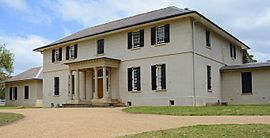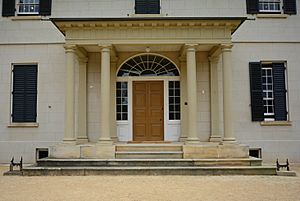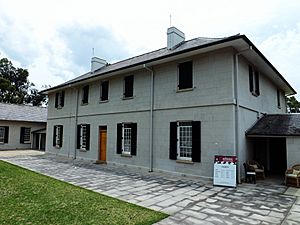Old Government House, Parramatta facts for kids
Quick facts for kids Old Government House |
|
|---|---|

Old Government House
|
|
| General information | |
| Type | Mansion |
| Architectural style | Old Colonial Georgian |
| Location | Parramatta Park, Parramatta, Greater Sydney, New South Wales |
| Country | Australia |
| Coordinates | 33°48′44″S 150°59′50″E / 33.812119°S 150.997359°E |
| Construction started | 1799 |
| Completed | 1820 |
| Client |
|
| Owner | National Trust of Australia (NSW) - Trustee |
| Grounds | 45 hectares (110 acres) |
| Design and construction | |
| Architect |
|
| Architecture firm | Colonial Architect of New South Wales |
| Type: | Cultural |
| Criteria: | iv, vi |
| Designated: | 2010 (34th session) |
| Part of: | Australian Convict Sites |
| Reference #: | 1306} |
| Region: | Asia-Pacific |
| Type: | Historic |
| Designated: | 1 August 2007 |
| Reference #: | 105957 |
| Type: | Historical |
| Designated: | 2 April 1999 |
| Reference #: | 00596 |
Old Government House is a historic building located in Parramatta, a suburb of Sydney, Australia. It was once a "country home" for ten of the first governors of the Colony of New South Wales between 1800 and 1847. A governor was the leader of the colony, representing the British monarch.
Today, Old Government House is Australia's oldest public building and is recognized as a site of national and international importance. It is furnished to look like it did in the 1820s and is open for visitors to explore. The house sits in a large park overlooking the Parramatta River.
The land on which the house stands is the traditional home of the Burramatta clan of the Darug nation. There is evidence of their long history here, including scarred trees where bark was removed for canoes and shell middens (piles of old shells).
In 2010, Old Government House was added to the World Heritage List as part of the Australian Convict Sites. This group of 11 sites shows the story of how European powers used convict labor to expand their colonies.
Contents
History of the House
The first Government House in Sydney was not very well built. The early governors wanted a better home away from the busy and growing town of Sydney. In 1799, Governor John Hunter decided to build a new house in Parramatta. It was built on the site of an earlier cottage that belonged to Arthur Phillip, the very first governor.
The house was built by convicts, who were people sent to Australia from Britain as punishment for crimes. The main part of the house you see today was finished in 1815 under Governor Lachlan Macquarie. He and his wife, Elizabeth, also designed the large park, known as the Domain, that surrounds the house.
For almost 50 years, this house was the center of government for the colony. Important decisions were made here that shaped the future of Australia. After 1847, the governors moved to a new Government House in Sydney, and this building was used for other purposes, including as a school.
A Look Inside and Out
Old Government House is a great example of Old Colonial Georgian architecture. This style is known for being simple, balanced, and elegant. The house is a two-story building with a large porch, or portico, at the front.
Inside, one of the most famous features is the black-and-white checkered floor in the entrance hall. In those days, floors like this were often made of expensive marble. But in the new colony, builders had to be creative. This floor is actually made of wood, painted to look like stone.
The house is surrounded by Parramatta Park. The park still has some of the original open woodlands and roads that follow the old carriage ways. It's a peaceful place where you can see what the landscape looked like in colonial times.
The Governor's Domain
The park around the house was once much larger and was called the Governor's Domain. It was used for farming to help feed the new colony. It was also a place for scientific discovery.
- The Crescent: This is a curved piece of land that was once part of the Parramatta River. Its rich soil was perfect for growing some of the first crops in the colony, which helped save the early settlers from starvation.
- Observatory Site: Governor Thomas Brisbane was very interested in astronomy. He built an observatory in the park in 1822. Although the building is gone, you can still see stones that marked its location and special "marker trees" that helped astronomers line up their telescopes. This was the beginning of scientific research in Australia.
- The Dairy: The governor's dairy building still stands in the park. It has been restored so visitors can see where milk and butter were produced for the house.
Other Buildings in the Park
As you walk through Parramatta Park, you can see other historic structures that were part of the Governor's Domain.
- Gatehouses: There are several gatehouses that mark the entrances to the park. The George Street Gatehouse, built in 1885, has a classic Tudor style. For many years, the family living there would provide hot water for people having picnics in the park.
- Governor's Bathhouse: Governor Brisbane built a bathhouse in 1823. Water was pumped from the river and heated for the governor's bath. Today, the building is an open pavilion, but it stands in its original spot.
- Boer War Memorial: This memorial was built in 1904 to honor soldiers who fought in the Boer War. It uses stone columns from an old courthouse in Parramatta.
Why is Old Government House Important?
Old Government House and its park are special for many reasons. They are listed as a World Heritage site, a National Heritage site, and a State Heritage site. This means they are protected for their historical value.
The site tells many important stories:
- It shows the history of the Aboriginal Darug people who have lived on this land for thousands of years.
- It is a powerful symbol of the British settlement of Australia and the beginning of the nation.
- It shows how convicts lived and worked, as they built the house and farmed the land.
- It is a beautiful example of early colonial architecture and landscape design.
Today, the National Trust of Australia takes care of the house, making sure it is preserved for future generations to visit and learn from.
See also
 In Spanish: Antigua Casa de Gobierno de Parramatta para niños
In Spanish: Antigua Casa de Gobierno de Parramatta para niños
- First Government House, Sydney, residence of the Governor from 1788 to 1845
- Government House, Sydney, the present residence of the Governor
- Cranbrook, Bellevue Hill, the residence of the Governor from 1900 to 1914
- Government Houses of Australia
- List of National Trust properties in Australia






